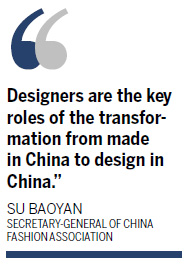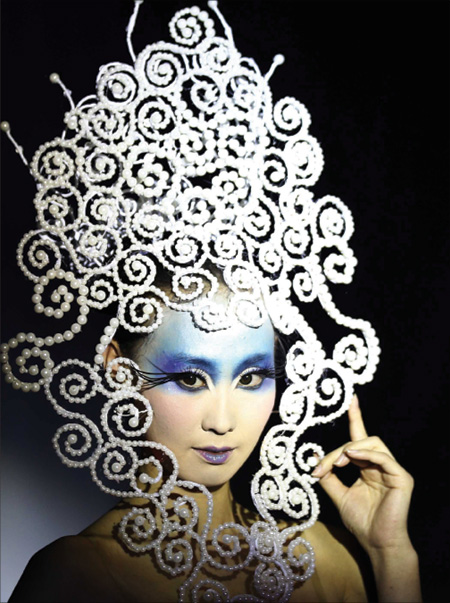Business
Foreign designers popular
Updated: 2011-06-17 11:08
By Lin Jing (China Daily)
|
|
BEIJING - Though Elisabeth Koch did not attend the Aprilweddingof Prince William and Kate Middleton in London, her tailor-made hats might have.
The American designer and the owner of Elisabeth Koch Millinery sent three hats to the bride.
Her reputation has grown since opening a business in Beijing.
After graduating from the Wombourne School of Millinery in the United Kingdom in 2007, Koch came to China with her husband and started her own line of hats.
 |
"For me, it was not that hard to start the business in China," Koch said. "At first, I went to different parties wearing my hats. People started to ask about my hats and we talked about possible business cooperation."
In 2008, her designs were featured in top American fashion magazine Harper's Bazaar, which was beyond her imagination. "How fast could that happen?" she said.
Her hats have been published in more than 50 magazines, both Chinese and international. Her rising reputation helps with her business as well. Her hats are priced from 1,500 yuan ($231) to 2,800 yuan, depending on the materials used. The most expensive one sold for 4,000 yuan.
Eight stores now sell her hats, seven in China and one in Paris. Sales have grown by 27 percent on average every year.
Her hats have been worn by celebrities such as Chinese actresses Zhang Ziyi and Li Bingbing, and also by royalty, including Princess Maxima of the Netherlands and the Duchess of Cambridge, aka Kate Middleton.
Koch has collaborated with Shanghai Tang, Swarovski, Ritz Carlton and is currently negotiating a contract with Lane Crawford.
As business keeps growing, she is looking for a bigger studio to increase production.
"My plan is to stay in Beijing and start sales in New York and London."
Koch's success is not accidental. In recent years, many foreign designers and studios have started businesses in China, especially in big cities. Though the number of foreign designers is quite small, they are popular in the local markets.
Many Chinese shoemakers and apparel companies, such Li-Ning and 361,have hired foreign designers to improve the look of their products.
"Big apparel companies prefer foreign designers to local ones, because foreign designers can raise their products' reputation and taste. In addition, they also have advantages in grasping the fashion trends," said Lan Lan, a lecturer at the Beijing Institute of Fashion Technology.
Because of this trend, Western designers are very popular in emerging markets, including China.
Meanwhile, China is in desperate need of fashion designers as the country transforms from a manufacturer to a creator. "There is a great demand for designers in the market," said Su Baoyan, secretary-general of China Fashion Association. "Currently there are about 50,000 apparel companies in China and new brands keep popping up every year. Besides, some existing brands are also developing new lines. All of these companies need fashion designers."
She, however, does not say how many designers China needs, but insists the number is big. "Every year there are only about 10,000 fresh designers graduating from design schools in China, and some of them will change to other professions, such as fashion editor, stylist and marketing assistant."
Su said that after the financial crisis, manufacturers in coastal areas of South China have fewer manufacturing orders from developed countries.
To stay afloat, these companies have to adjust their business models and transform from manufacturers to creators.
"Designers are the key roles of the transformation from 'made in China' to 'design in China'. Without them, it's a mission impossible," Su said.
Consumer needs evolve rapidly in China, and apparel brands have to change accordingly to win business.
"These companies need designers to catch up with the fashion trends and keep their customers. The demand for fashion designers, especially experienced ones, keeps on increasing," Su said.
Lan said that China is relatively new to the fashion world, which can be a hindrance to up-and-coming designers.
"In China, the fashion industry does not have a long history as that in the West. Foreign designers have known about, seen and even used many fashion products during their early ages, while most Chinese fashion designers may have not even heard of these fashion brands till their college years. As a result, they have to make up the gap within a short period of time."
Though there are more than 200 design schools in China, classes tend to emphasize more on the creations than the business aspect.
"Fashion designers are different from artists. Artists work for themselves and can let their imagination fly, while designers have to be more organized and business-orientated," Lan said.
In the industry, Lan added, a fashion designer is in charge of the complete processes, from product design to the final delivery, including fabric choices, cost control and target customers.
"After all, designers have to bear business and customers' needs and requirements in minds. Their designs and products are supposed to be understandable to their bosses and target clients and help increase sales."
Federick Wong, program director of the fashion design department at Raffles Design Institute in Beijing, said the most urgent issue is finding a way to nurture new designers.
"To become professional fashion designers, school training is far from enough. And young designers need a good platform to grow and mature after graduation."
Wong, a Chinese-Malaysian, said that it takes at least five years of working experience to become a professional designer. And many fresh graduates can only work as assistant designers because of the lack of experience.
Wong suggested that the government as well as design schools should give young designers more chances to get hands-on experience.
"Fashion schools could set up incubation centers for young designers to experiment with their ideas, their business plans and designs. Meanwhile, more cooperation between schools and apparel companies in real-time projects is also helpful. These projects could familiarize young designers with the industry much earlier and help enterprises select the designers they need."
Wong also said that most Chinese fashion designers find it hard to promote themselves.
Fashion shows can help advertise new designers, but it can be a struggle financially to start a new business.
"The beginning salary for a designer is about 3,000 yuan to 5,000 yuan. But a one-hour fashion show costs around 1 billion yuan, not including the cost of staging, lights, music and models, which is beyond the financial abilities of most young designers."
German fashion designer Katrin Reinfurt said that young Chinese fashion designers have great potential to become great, globally known designers, and what China needs is a fashion district.
"International fashion designers are well known for the fine marketing and big shows in fashion centers such as Paris, but it is difficult for Chinese fashion designers to hold fashion shows in Europe, because of the distance and huge cost.
"The problem in China is that it does not have a gathering place where fashion media, journalists, designers and models could come together and join the marketing process."
Reinfurt said that Chinese designers look too much to fashion cultures from the West and are short of originality in their own designs. In the long term, he said, Chinese designers should form their own fashion style.
"Instead of drowning in the other trends, they (Chinese designers) should try to concentrate on their own culture, and find out their own design signatures," Reinfurt said.
"Fashion design is like a mirror of society. Designers should combine their designs with the Chinese culture, learn to express their own identities and dress codes, and reflect what is going on in society," she said.
Jacky Jin, vice-president of Trends Media Group, a fashion magazine publisher in China, said that there is still a lot of room for improvement for Chinese designers.
"In the West, fashion designers are not only designers, but also fashion icons who provide ideas and promote fashion styles, such as John Galliano and Karl Lagerfeld. But in China, designers are confined to a certain role and can hardly shoulder so many roles at the same time."
Since the 1990s, some Chinese designers chose to study in world fashion centers such as the United Kingdom, Italy and France.
Jin said that it is really helpful for them to see different things and open their eyes and minds.
"These Chinese designers have a thorough understanding of local markets by working or intern experiences in international apparel companies. With advanced management skills and design experiences, they have great potential of becoming world-class designers."
China Daily

Specials

Ciao, Yao
Yao Ming announced his retirement from basketball, staging an emotional end to a glorious career.

Turning up the heat
Traditional Chinese medicine using moxa, or mugwort herb, is once again becoming fashionable

Financial sector short of talent
Lack of skilled professionals in Shanghai inhibiting the city's development as a financial hub
